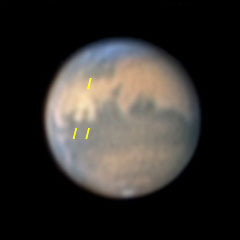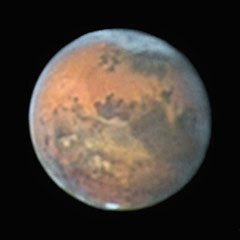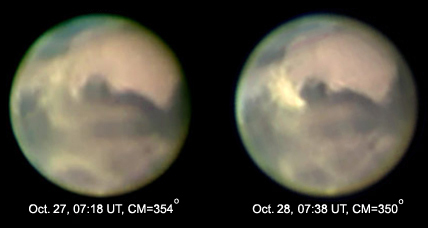
By October 18th, with summer advancing in Mars's southern hemisphere, a V-shaped dust storm had developed in the Chryse region. (Yellow ticks mark the upside-down V's ends and point.) Click on the image to see how the dust clouds changed and spread in the following two days. Mars observers were becoming concerned that the dust storm could grow and widen to blanket the whole planet, hiding surface features as happened at the Mars opposition of 2001. For this image, taken at 3:04 UT, Sky & Telescope assistant editor Sean Walker used a ToUcam Pro 740 webcam at f/50 on a 7-inch Maksutov-Newtonian telescope, then stacked the video frames using RegiStax freeware. North is up.
Photo by Sean Walker.
Updated November 9th
Planetary observers have been watching Mars with increased interest since the planet's first local dust storm this season was reported on October 14th. That storm, in the Chryse region, died down, but another, larger one sprung up on October 17th in the same area and spread southward. By the morning of October 20th, this storm grew to obscure much of Aurorae Sinus, visibly filling the Valles Marineris canyon and spilling southward over Mare Erythraeum. In the following days it spread further, thinned out, and formed a pale, bright rim in the planet's far-southern latitudes.
Another dust outbreak appeared in the Chryse area around October 25th; it too spread south. And then on the morning of October 28th, yet another event began in the same general area — a brilliant arc of thick dust erupting between Sinus Meridiani and Margaritifer Sinus, as seen at the bottom of this page. "This is an incredible outbreak that I have never seen the intensity of before," said longtime planetary observer P. Clay Sherrod, who took the picture. In the next few days it too spread southward and westward (Martian west; celestial east, or "following") to form a large, widening arc. And it was followed by yet another wave of dust starting in the Sinus Meridiani region and progressing outward in the same pattern.
Meanwhile, an odd, new brick-red patch has developed on the edge of Mare Erythraeum south of Sinus Meridiani. It caught the attention of several imagers. One of them, Timothy Parker of NASA, speculates that the red feature represents ground with its dust coating newly stripped off. "I worked on the Mars Pathfinder and MER rover missions," he writes, "and found that just underneath the bright reddish surface, the soil had that brick reddish color when disturbed."
Interestingly, "Mare Erythraeum" means "red sea" — after a classical name for the supposedly sunset-colored Indian Ocean, not today's Red Sea. The name was bestowed by the first great Mars mapper, Giovanni Schiaparelli, in 1877.
By November 9th the series of dust storms seemed to diminish.
Dust storms are relatively common on Mars suring the southern hemisphere's summer, growing and then fading out within days or weeks. But occasionally an event can grow fierce enough to encircle the entire globe, as happened around Mars's 2001 opposition. Fortunately, only 10 of these events have been recorded over the past 130 years.

Ed Grafton in Houston, Texas, imaged Mars on five successive nights from October 16–17 to 20–21 while the dust storm that began in Chryse spread southward across Mare Erythraeum and Solis Lacus. He took this shot on the 21st Universal Time. The dust is the wide, pale-yellowish veil extending from the center partway down. Click image for the animated sequence. Grafton used a 14-inch Schmidt-Cassegrain telescope at f/39 with an SBIG ST-402 CCD camera. North is up.
Courtesy Ed Grafton.
Scientists working with the Mars Exploration Rover missions, particularly Opportunity on Sinus Meridiani, express little concern about the dust events. "We think the rovers could survive a local or regional dust storm of a few days or weeks just fine", says project scientist Joy A. Crisp of NASA's Jet Propulsion Laboratory. "In the event of a planet-wide dust storm, our solar energy would be significantly reduced. It's also possible that we might have to 'hibernate' for a while during the worst part of a dust storm. How we would fare would also depend on how much dust was on the solar panels at the onset of the storm and the seasonal temperature range we were in at the time." Opportunity weathered the dust events in its vicinity just fine, with no effects other than a reduction of solar energy from the dust-dimmed Sun.

Between the mornings of October 27th and 28th, a brilliant dust cloud blew up between Sinus Meridiani (just to its right here) and Margaritifer Sinus (just to its left). North is up.
Images by P. Clay Sherrod.
For more on observing Martian dust storms, see "Storm Watch on Mars" by Donald C. Parker and Jeffrey D. Beish (Sky & Telescope, July 2003, page 107; online back issues available). A complete guide to this year's Mars apparition, with a surface-feature map and rotation timetable, is in the September 2005 issue of Sky & Telescope, page 67.
 0
0









Comments
You must be logged in to post a comment.